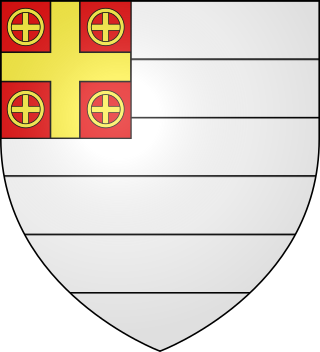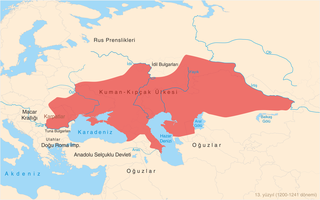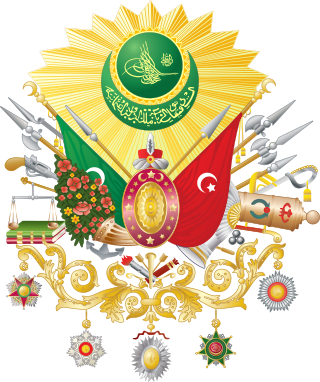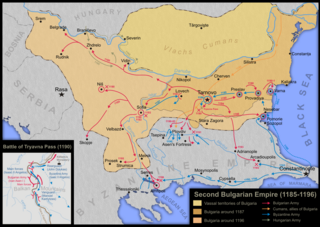Related Research Articles

The House of Asen, also Asen dynasty or the Asenids, founded and ruled a medieval Bulgarian state, called in modern historiography the Second Bulgarian Empire, between 1185 and 1280.

The Military Frontier was a borderland of the Habsburg monarchy and later the Austrian and Austro-Hungarian Empire. It acted as the cordon sanitaire against incursions from the Ottoman Empire.

The Kipchaks or Qipchaqs, also known as Kipchak Turks or Polovtsians, were Turkic nomads and then a confederation that existed in the Middle Ages inhabiting parts of the Eurasian Steppe.

The rise of the Ottoman Empire is a period of history that started with the emergence of the Ottoman principality in c. 1299, and ended c. 1453. This period witnessed the foundation of a political entity ruled by the Ottoman Dynasty in the northwestern Anatolian region of Bithynia, and its transformation from a small principality on the Byzantine frontier into an empire spanning the Balkans, Anatolia, Middle East and North Africa. For this reason, this period in the empire's history has been described as the "Proto-Imperial Era". Throughout most of this period, the Ottomans were merely one of many competing states in the region, and relied upon the support of local warlords Ghazis and vassals (Beys) to maintain control over their realm. By the middle of the fifteenth century the Ottoman sultans were able to accumulate enough personal power and authority to establish a centralized imperial state, a process which was achieved by Sultan Mehmed II. The conquest of Constantinople in 1453 is seen as the symbolic moment when the emerging Ottoman state shifted from a mere principality into an empire therefore marking a major turning point in its history.

The military of the Ottoman Empire was the armed forces of the Ottoman Empire. It was founded in 1299 and dissolved in 1922.

Akçakoca is a town in Düzce Province, in the West Black Sea Region of Turkey, located about 200 km east of Istanbul. It is the seat of Akçakoca District. Its population is 27,878 (2022). The town was named after a Turkish chieftain of the 14th century CE who captured the area for the Ottoman Empire, and sports a statue in his honor. The town features a modern mosque of unusual design. Tourist attractions include beaches and a small ruined Genoese castle. It is the regional center of hazelnut cultivation.

The Cumans or Kumans were a Turkic nomadic people from Central Asia comprising the western branch of the Cuman–Kipchak confederation who spoke the Cuman language. They are referred to as Polovtsy in Rus', Cumans in Western and Kipchaks in Eastern sources.

The name Cumania originated as the Latin exonym for the Cuman–Kipchak confederation, which was a tribal confederation in the western part of the Eurasian Steppe, between the 10th and 13th centuries. The confederation was dominated by two Turkic nomadic tribes: the Cumans and the Kipchaks. Cumania was known in Islamic sources as Dasht-i Qipchaq, which means "Steppe of the Kipchaks" or "Plain of the Kipchaks" in Persian, and al-Qumāniyīn in Arabic. Russian sources have referred to Cumania as the "Polovtsian Steppe", or the "Polovtsian Plain".
Cuman or Kuman was a West Kipchak Turkic language spoken by the Cumans and Kipchaks; the language was similar to today's various languages of the West Kipchak branch. Cuman is documented in medieval works, including the Codex Cumanicus, and in early modern manuscripts, like the notebook of Benedictine monk Johannes ex Grafing. It was a literary language in Central and Eastern Europe that left a rich literary inheritance. The language became the main language of the Golden Horde.

The Uprising of Asen and Peter was a revolt of Bulgarians and Vlachs living in Moesia and the Balkan Mountains, then the theme of Paristrion of the Byzantine Empire, caused by a tax increase. It began on 26 October 1185, the feast day of St. Demetrius of Thessaloniki, and ended with the restoration of Bulgaria with the creation of the Second Bulgarian Empire, ruled by the Asen dynasty.

Grenz infantry or Grenzers or Granichary were light infantry troops who came from the Military Frontier in the Habsburg monarchy. This borderland formed a buffer zone between Christian Europe and the Ottoman Empire, and the troops were originally raised to defend their homelands against the Ottoman Turks. When there was no danger of war against the Ottomans, the Grenzer regiments were employed by the Habsburgs in other theatres of war, although one battalion of each regiment would always remain guarding the border.

The Palaiologan army refers to the military forces of the Byzantine Empire under the rule of the Palaiologos dynasty, from the late 13th century to its final collapse in the mid-15th century. The army was a direct continuation of the forces of the Empire of Nicaea, which itself was a fractured component of the formidable Komnenian army of the 12th century. Under the first Palaiologan emperor, Michael VIII, the army's role took an increasingly offensive role whilst the naval forces of the empire, weakened since the days of Andronikos I Komnenos, were boosted to include thousands of skilled sailors and some 80 ships. Due to the lack of land to support the army, the empire required the use of large numbers of mercenaries.

In AD 1453, the city of Constantinople, the capital and last stronghold of the Byzantine Empire, fell to the Ottoman Empire. By this time Egypt had been under Muslim control for some eight centuries. Jerusalem had been conquered by the Rashidun Caliphate Muslims in 638, won back by Rome in 1099 under the First Crusade and then reconquered by Saladin's forces during the siege of Jerusalem in 1187. Later in the seventh Crusade, it was briefly taken back by the Catholics once again. It was conquered by the Ottomans in 1517. Orthodoxy, however, was very strong in Russia which had recently acquired an autocephalous status; and thus Moscow called itself the Third Rome, as the cultural heir of Constantinople. Under Ottoman rule, the Greek Orthodox Church acquired power as an autonomous millet. The ecumenical patriarch was the religious and administrative ruler of the entire "Greek Orthodox nation", which encompassed all the Eastern Orthodox subjects of the Empire.
Voynuks were members of the privileged Ottoman military social class established in the 1370s or the 1380s. Voynuks were tax-exempt non-Muslim, usually Slavic, and also non-Slavic Vlach Ottoman subjects from the Balkans, particularly from the regions of southern Serbia, Macedonia, Thessaly, Bulgaria and Albania and much less in Bosnia and around the Danube–Sava region. Voynuks belonged to the Sanjak of Voynuk which was not a territorial unit like other sanjaks but a separate organisational unit of the Ottoman Empire.
Yaya or Piyade were infantry military units of the Ottoman Empire and some other medieval Anatolian beyliks. Many of them were of Christian origin.
Derbendcis or Derbentler were the most important and largest Ottoman military auxiliary constabulary units usually responsible for guarding important roads, bridges, fords or mountain passes. Usually, the population of an entire village near some important pass would be assigned with derbendci status in exchange for tax exemptions.
Vlachs was a social and fiscal class in several late medieval states of Southeastern Europe, and also a distinctive social and fiscal class within the millet system of the Ottoman Empire, composed largely of Eastern Orthodox Christians who practiced nomadic and semi-nomadic pastoral lifestyle, including populations in various migratory regions, mainly composed of ethnic Vlachs, Serbs and Albanians. From the middle decades of the 17th century the amalgamation of the process of sedentarization of the Orthodox Vlachs and their gradual fusion with Serbian rural population reached a high level and was officially recognized by the Ottoman authorities.
Uzes were a group of medieval Turkic people in East Europe. They were known as Tork in Russian chronicles. Like most medieval Turkic people, they were Tengrists.

Manavs or Manav Turks are a Turkic people living in northwest Anatolia, especially in Sakarya, Bilecik, Balıkesir, Bursa, Çanakkale, Kocaeli, Eskişehir, Bolu and Düzce provinces. It is proposed that Manavs descend from Cumans and Kipchaks who settled in the Byzantine Empire.
References
- 1 2 3 4 5 6 7 8 9 10 11 12 13 Bosworth 1989, p. 613.
- 1 2 Uyar & Erickson 2009, p. 64.
- 1 2 3 4 Agoston & Masters 2009, p. 353.
- ↑ Yalvar, Cihan (19 February 2021). "CİHAN YALVAR, ANADOLU'DA SON TÜRK İSKÂNI: İZNİK İMPARATORLUĞU'NDA KUMAN-KIPÇAKLAR VE YALOVA KAZIMİYE (YORTAN) İLE ELMALIK (SARUHANLI) KÖYLERİNDEKİ VARLIKLARI". Türk Dünyası Araştırmaları. 127 (250): 11–36.
- ↑ Yılmaz, Adil (20 March 2024). "Geyikdere Köyü Mezarlığında Bulunan Orta Asya Tipindeki bir Taş Heykel, Adil Yılmaz". academia.edu. Retrieved 20 March 2024.
- ↑ Ivo Banac; (1984) The National Question in Yugoslavia: Origins, History, Politics p. 43; Cornell University Press, ISBN 0801416752
- ↑ Kursar Vjeran; (2013) Being an Ottoman Vlach: On Vlach Identity(ies), Role and Status in Western Parts of the Ottoman Balkans (15th-18th Centuries) p. 134; . OTAM. Ankara. 34
- ↑ Uyar & Erickson 2009, pp. 63–64.